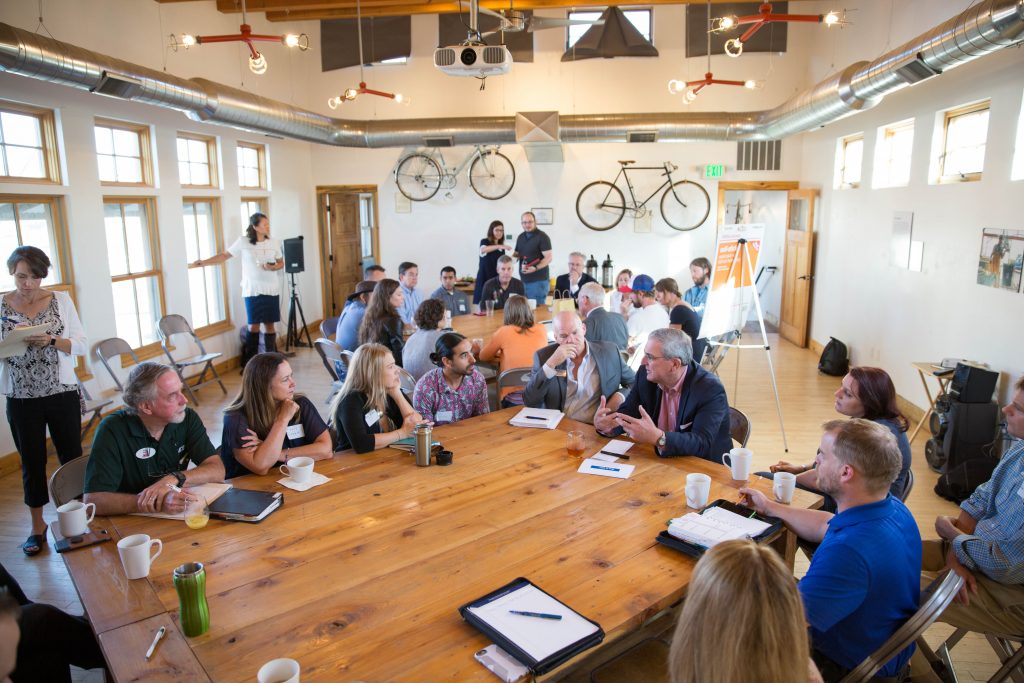Attracting and Managing New Resources and Partners that Respond to Community Needs

By Megan Sheekey, Bloomberg Associates
The COVID-19 pandemic and resulting economic crisis have brought increased focus on the benefits of strong cross-sector collaboration in addressing issues including food insecurity, housing stability, and vaccine distribution. With pressure to meet complex needs, can local governments effectively lead these collaborative efforts? The short answer is yes. In the wake of the pandemic, mayors and city administrators around the world are cultivating and managing new and creative partnerships to respond to immediate demands and the changing needs of their residents. These government leaders are also recognizing that partnerships require resources and structure to be successful.
Recently, over 130 mayors and municipal senior staff came together for a virtual Bloomberg Philanthropies workshop on strategic partnerships to share experiences and lessons learned before and during the pandemic.
Leadership Matters
In a conversation led by Columbia, South Carolina Mayor Steven Benjamin, Birmingham, Alabama Mayor Randall Woodfin and Birmingham-based CEO Lee Styslinger of Altec, Inc. discussed how to foster and lead public-private collaboration. Mayor Benjamin posed the question: “How do you create a culture of collaboration inside city government and also spark innovation and attract partners externally?”
Mayor Woodfin, who has made collaboration a hallmark of his administration, noted that creating this culture inside government can start with the Mayor, but it needs to be embraced throughout all city departments. He said, “For any city to be successful, you have to believe in a three-legged stool.” He explained, “That’s not just the public sector, but the second leg, in no particular order, is the private sector, and then the third leg is the nonprofit and foundation world. Everybody has to be on the same page in order to move your community. Tax dollars in isolation and government cannot create change, you have to have partners at the table, which includes the private sector.”
On Birmingham’s COVID-19 response efforts, Mayor Woodfin reflected “If there was ever a time to really triple down on public-private partnerships, it was 2020. We had three crises in one year– the global health pandemic, the economic recession, as well as civil unrest, and there’s no playbook for dealing with one of them, but definitely not three at one time.” And with the uncertainty of if or when the federal government would direct resources to localities, the Woodfin Administration looked to partners to help create its own loan program for local businesses. It also launched BhamStrong, a public-private partnership created to support local small business owners and residents.
Lee Styslinger shared that the transparency and openness in the current city administration has helped to build a level of trust between partners, along with strong community engagement. “The ownership at the local neighborhood level of initiatives is crucial—it can’t be something that me, as a business leader, proposes. I want to be as far in the background as possible and know that constituents, and neighborhoods, are the driving force.” He also noted the progress Birmingham has made in recent years due to the Woodfin administration’s focus on partnerships, adding: “When people come together with the right platform, the right dialogue in working and leveraging combined resources towards economic inclusion and economic prosperity for all, the results can be transformative.”
Prioritizing Structure and Management
So how are cities overseeing and managing cross-sector partnerships? Many municipalities have allocated (or privately raised) resources for dedicated staff to manage these efforts. Detroit’s Chief Development Officer Sirene Abou-Chakra and Director of Fort Collin’s City Give program Nina Bodenhamer shared how they are structuring strategic partnerships in their cities.
Under Sirene’s oversight in Detroit, funding priorities are established by the mayor or by department directors and approved by the mayor. Her office charts all fundraising priorities and creates worksheets to fully understand the project scope, need, and timeline. She then assesses initiatives with her Chief Financial Officer to make sure those needs are in line with the city’s broader budget and priorities.
“My department is similar to air traffic control, so we can go out to funding sources and all of our requests are part of one narrative that we are sharing with our nonprofit and philanthropic community,” shared Sirene. “But the only way that you go from $300 to $700 million in external investments [as Detroit has done since last year], is not necessarily by finding new funders but by convincing existing ones that their investment is worthwhile and being able to build and maintain collaborative relationships.”
Fort Collins employs a similar approach through a program called City Give, which manages philanthropic support for municipal priorities. Nina, who oversees this initiative, stresses the need for a skilled team to manage partnerships. “We housed City Give within the financial services division of our municipality, and that gave us one entry point for every gift as well as the tracking and the metrics to measure revenue stream and movement. So, we can see how funds are being spent, look at the project budgets and, importantly, report back to the funders, which provides the critical transparency and alleviates donor concerns.”
Nina echoed the need for strong community engagement in partnerships. “We are committed to involving our community in authentic, intentional ways,” she said, and reporting out on the activities of her office is a part of that process.
Our Collective Force
Mayor Benjamin summed up the workshop for city leaders best: “If you collaborate, design properly, and pull in all the right forces, you get to the ultimate goal which, in the last year has been the preservation of human life, and I think that is so critical.”
The pandemic has certainly highlighted the significance of strong cross-sector collaboration, and municipalities that are devoting attention to management and engagement efforts around this work are seeing positive returns. Bloomberg Philanthropies looks forward to creating more opportunities for city leaders to come together and share lessons on strategic partnerships.